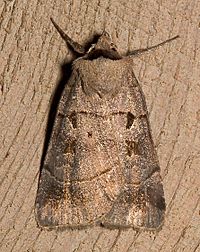Pale-banded dart facts for kids
Quick facts for kids Pale-banded dart |
|
|---|---|
 |
|
| Scientific classification | |
| Kingdom: | |
| Phylum: | |
| Class: | |
| Order: | |
| Family: | |
| Genus: |
Agnorisma
|
| Species: |
A. badinodis
|
| Binomial name | |
| Agnorisma badinodis Grote, 1874
|
|
| Synonyms | |
|
|
The Agnorisma badinodis is a type of moth also known as the pale-banded dart or spotted-sided cutworm. It belongs to the Noctuidae family, which includes many different kinds of moths.
This moth is found in North America. You can spot it in southern Canada and across the United States. It lives mainly in areas east of the 100th meridian, but not in the very southern parts of the country.
About the Pale-Banded Dart Moth
The pale-banded dart moth is a fascinating insect. It has a wingspan of about 36 millimeters (which is about 1.4 inches). This means its wings stretch out about that far from tip to tip.
Life Cycle
These moths have one generation per year. This means that from egg to adult, their full life cycle happens once within a year. They lay eggs, which hatch into caterpillars, then turn into pupae, and finally emerge as adult moths, all within a single year.
What It Eats
The caterpillars of the pale-banded dart moth enjoy munching on various plants. They are known to eat plants like:
- Stellaria media (also known as chickweed)
- Sisymbrium officinale
- Different types of Trifolium
- Medicago sativa
- Plants from the Rumex genus (like docks and sorrels)
- Symphyotrichum ericoides (a type of aster)
- Triticum aestivum
These plants provide the energy and nutrients the caterpillars need to grow before they transform into moths.

